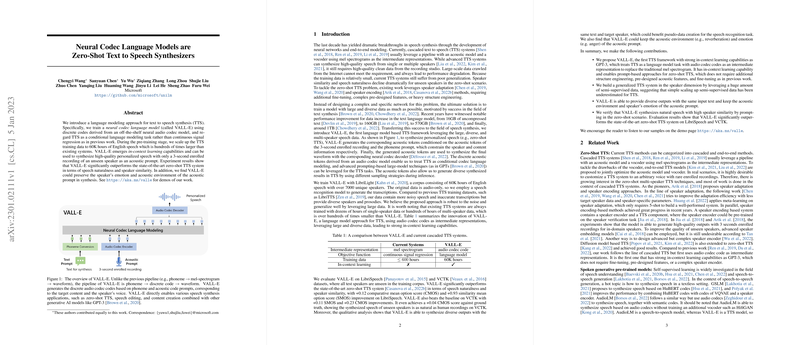Neural Codec LLMs for Zero-Shot Text-to-Speech Synthesis
The paper "Neural Codec LLMs are Zero-Shot Text to Speech Synthesizers" presents a novel approach to addressing the challenge of high-quality Text-to-Speech (TTS) synthesis for unseen speakers using a large-scale, LLM-based framework named VALL-E. Unlike traditional cascaded TTS systems, which rely on mel-spectrograms and signal regression models, VALL-E employs discrete audio codec codes as intermediate representations and treats TTS as conditional LLMing.
Methodology
VALL-E's methodology revolves around converting the continuous speech signal into discrete tokens using a neural audio codec model, specifically EnCodec. This conversion allows the model to handle TTS tasks as a sequence prediction problem in a discrete token space. The approach consists of two primary components:
- Autoregressive (AR) Model: Responsible for generating the initial level of discrete tokens based on phoneme sequences and a short acoustic prompt (an enrolled recording of the target speaker).
- Non-Autoregressive (NAR) Model: Utilized for subsequent levels of token predictions, which refine the output by capturing finer acoustic details. This model benefits from a hierarchical structure where each level depends on the previously generated tokens and the phoneme and acoustic prompts.
The neural codec model, EnCodec, quantizes the audio into eight residual vector quantization (RVQ) levels, each providing incremental details for speech synthesis. This structured quantization enables the AR model to capture general features and the NAR model to add specific nuances, ensuring high-quality and natural speech synthesis.
Experimental Results
The evaluation of VALL-E was meticulously conducted on datasets like LibriSpeech and VCTK, focusing on zero-shot scenarios where the model encounters speakers not seen during training. The key findings include:
- LibriSpeech Evaluation: VALL-E outperformed state-of-the-art systems in both robustness, as indicated by lower word error rates (WER), and speaker similarity, measured by similarity scores using WavLM-TDNN. Specifically, VALL-E achieved a WER of 5.9% compared to the 7.7% of the baseline, YourTTS.
- VCTK Evaluation: VALL-E demonstrated superior speaker similarity scores despite not having seen any VCTK speakers during training. This result underscores its efficacy in generalizing speaker identity.
Human evaluation metrics, including Comparative Mean Opinion Score (CMOS) and Similarity MOS (SMOS), were also presented. VALL-E achieved a CMOS improvement of +0.12 and +0.11 over YourTTS and +0.23 over YourTTS on a mixed set of seen and unseen speakers from VCTK, showcasing its ability to produce more natural and speaker-similar synthesis.
Implications
The implications of the VALL-E framework are far-reaching:
- Practical Applications: The proposed model's ability to perform high-quality TTS for unseen speakers with just a few seconds of enrolled speech introduces significant potential for applications in personalized digital assistants, voice cloning for content creation, and accessibility technologies for individuals with speech impairments.
- Future TTS Systems: The shift from mel-spectrogram and signal regression models to discrete token-based LLMs represents a paradigm shift in TTS development. This method leverages advancements in LLMing to achieve better generalization and robustness in speech synthesis.
- Acoustic and Emotional Consistency: VALL-E's capacity to maintain the acoustic environment and speaker's emotion from the acoustic prompt adds another dimension of realism and applicability, particularly useful in dynamic and context-aware voice applications.
Future Directions
The paper acknowledges several limitations and points towards future developments:
- Synthesis Robustness: One current challenge is the occasional errors in word clarity and alignment. Future work is proposed to incorporate non-autoregressive models or modified attention mechanisms to improve these aspects.
- Data Coverage: While 60K hours of training data is extensive, further expanding this dataset to include more diverse speaking styles, accents, and environments could address current limitations in generalization performance.
- Model Architecture: Future iterations of VALL-E could explore the integration of both AR and NAR models into a single, universal model, potentially improving efficiency and performance.
Conclusion
The VALL-E framework introduced in this paper represents a significant advancement in zero-shot TTS, leveraging neural codec LLMs to achieve superior naturalness and speaker similarity. Its ability to handle diverse acoustic conditions and speaker emotions further enhances its applicability across a wide range of speech synthesis scenarios. Continued development along the outlined future directions could potentially address current limitations and bring us closer to solving the challenge of universal, high-fidelity TTS.
